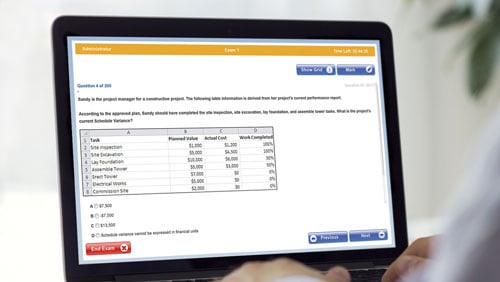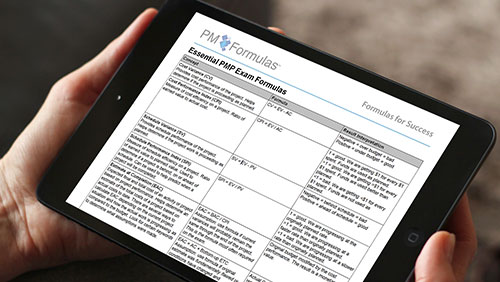Project and Process Tailoring for the PMP® Exam
 According to A Guide to the Project Management Body of Knowledge (PMBOK® Guide) a project is “a temporary endeavor undertaken to create a unique product, service or result”. Being that each project is unique it is important to also understand that an organization's project management processes will likely need to be tailored in order to ensure project success. Project tailoring takes into consideration that project management processes are not "one size fits all", meaning there will be many times when processes need to be adjusted (added, removed, or revised) in order to ensure project success.
According to A Guide to the Project Management Body of Knowledge (PMBOK® Guide) a project is “a temporary endeavor undertaken to create a unique product, service or result”. Being that each project is unique it is important to also understand that an organization's project management processes will likely need to be tailored in order to ensure project success. Project tailoring takes into consideration that project management processes are not "one size fits all", meaning there will be many times when processes need to be adjusted (added, removed, or revised) in order to ensure project success.
Tailoring in project management can happen at any time and for any process being applied to a project. Organizations often have a project methodology in place and may realize that this methodology needs to allow for adjustments to best manage a variety of projects. As a project manager you cannot blindly follow a methodology, you need to know how to assess a project to determine what processes will need to be adjusted in order to achieve a successful outcome for your project. Here we are going to look at a very high level method for process tailoring. This four step method includes: evaluating existing processes, assessing the project, documenting the tailoring process, and re-evaluating.
Evaluate Existing Project Management Processes
Before you can even consider tailoring processes to meet the needs of your project you need to fully understand the project management methodology and processes utilized by your organization. Some organizations implement the philosophy of setting a base list of processes that must be utilized for each project and allowing for adding processes as long as the base requirements are met. Some organizations identify all possible processes that may be utilized for a project and allow for the removal of some if not most of the processes depending upon the project needs. Others may employ a strict method that must be adhered to and may not be altered without prior approval. Prior to doing any project tailoring it is best to fully understand the processes and know your organization's stance on making adjustments in order to best tailor those processes for your project.
Assess the Project Tailoring Needs
Assessing the project tailoring needs can be completed by asking questions in regards to each of the project management knowledge areas to determine which processes are required for project success and which may need to be adjusted. Below is a small list of example questions a project manager may want to ask when tailoring their project. Each project is unique, so you should develop a list of questions to best fit your project.
Project Integration Management:
• Is this a phased project and if so, how many phases will this project have?
• What is the size / complexity of the project and how will it impact the project management plan?
Project Scope Management:
• Will we use Agile or Waterfall?
• Are the project requirements clearly or loosely defined?
Project Time Management:
• How is time spent on the project logged by everyone?
• Does the project need to be fast tracked?
Project Cost Management:
• What tools will be utilized to track actual spending?
• Is the project team managing finances or do we need to involve the finance department?
Project Quality Management:
• Does the organizational quality policy affect this project?
• Are there any regulatory quality requirements that impact this project?
Project Human Resources Management:
• Are required skills available in-house to complete this project or will resources need to be hired?
• Will the project team be co-located or virtual?
• Have they worked together previously?
Project Communications Management:
• Will project team members be allowed to directly communicate with stakeholders or will all communication need to go through the project manager?
• What are the preferred communication methods of the project team and stakeholders?
Project Risk Management:
• What would be the impact to the organization if the project were to fail?
• How much risk management is “right” for the project?
Project Procurement Management:
• Will the project management team have the authority to sign contracts or will this be done by a procurement or legal department?
• What level of approval will the project team have for purchases ($100, $1,000, $10,000, etc.)?
Project Stakeholder Management:
• Are the Stakeholders physically located near the project?
• What is the anticipated involvement of the stakeholders?
Document the Project Tailoring Process
As part of the project you need to document the tailoring process approach in the project management plan. As the processes are tailored you also need to document how each process was tailored and why it was added, removed, or revised. This serves two functions. One is to document all of the adjustments made as part of the tailoring process to have a good record of the project for close out purposes. The second is to show which tailored processes worked well, and which ones may need further adjustment for future projects. By documenting the tailored processes, process tailoring guidelines and project tailoring checklists can be developed (or improved upon if already existing) to improve the process of tailoring for future projects within the organization.
Re-Evaluate Project Management Processes
Just as with many project management processes, you can't just tailor a process and walk away. As the project progresses, it is vital to re-evaluate the processes being used to determine if the tailoring is working as planned and if additional adjustments are necessary. This can be completed formally at the start of a new phase if this is a phased project or even informally as part of the project status meetings. No matter the method you chose to re-evaluate, document the approach and the results both as part of your project documentation.
Project process tailoring is a good project management practice that helps ensure a successful project outcome. A project manager should not blindly apply a methodology, but instead should evaluate the existing processes, assess the project to be completed, document any process tailoring completed, and re-evaluate the tailoring process as the project proceeds. Here we have provided a high level project process tailoring method that you can apply to your projects.


